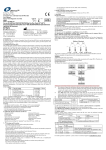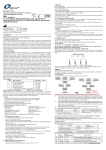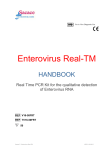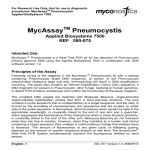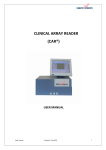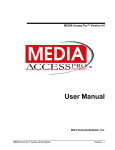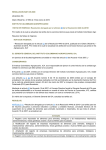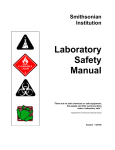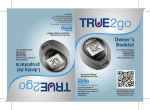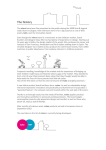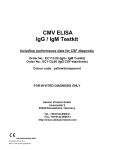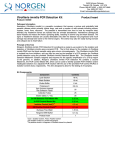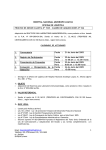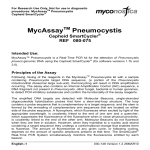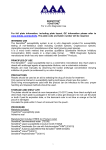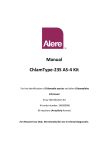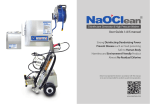Download View Category B-Biological Specimen Shipping Booklet
Transcript
Shipping Biologic Specimens Shipping Specimens for Testing How Do I Ship Specimens For Laboratory Testing? Packing instructions differ based on (1) potential hazard of specimens, (2) transport temperature required and (3) volume of specimens you will ship. Before you begin, you must know these three things about your specimen shipment, and be trained and certified in the appropriate hazmat shipping regulations. Your employer is responsible for this training. Before shipping biologic specimens, please read this booklet for important specimen preparation, packaging, and shipping information. Then follow the specific packing instructions included with the mailing kits provided. Reading this booklet by itself does not constitute hazmat training or certification. Potential Hazard The three hazard categories for specimens are Medical, Biologic, and Infectious: Medical Specimens are defined as clinical specimens in which any known or suspected pathogens have been inactivated or neutralized so that it cannot cause disease if exposure to it occurs. Biopsied tissue in 10% formalin is an example of a Medical Specimen. Biologic Specimens are defined as any human or animal excreta, secreta, blood, tissue or tissue fluid which may contain pathogens that can cause human or animal disease for which there are effective treatments and preventative measures available, and the risk of spread of infection is limited. Pathogens of this nature are also called Category B pathogens. Infectious Specimens are those known to contain or suspected of containing pathogens that, when exposure to it occurs, is capable of causing permanent disability, life-threatening or fatal disease to humans or animals. Pathogens of this nature are also called Category A pathogens (see Appendix). Please call Client Services before sending highly infectious cultures, or specimens from a patient that may have been exposed to a highly infectious agent. Special packaging and handling is required for these types of specimens. This booklet contains instructions for shipping Biologic Specimens ONLY. Medical Specimens are not subject to these regulations, and should NOT be transported as Biologic Specimens. Biopsy mailing kits include instructions for shipping Medical Specimens. If the specimens you are shipping do not meet requirements for a Biologic or Medical Specimen as defined above, please call EMHRL for Infectious or other packing instructions. Transport Temperature Use Appendix 2 to determine which mailing kit will provide the appropriate transport temperature and specimen capacity you will need for the type and number of specimens you are transporting. Volume of Specimens to Ship The shipper must be large enough to hold ALL specimens you will be shipping in (1) 24-hour period, and must not exceed regulatory limits for total specimen volume/weight. Elmhurst Memorial Reference Laboratory Biologic Specimen Shipping; page 1 Shipping Fees and Policies Priority Overnight Shipping If you elect to use our express shipping service provided by FedEx to ship biologic specimens, we will provide you with shipping materials and airbills. A shipping surcharge will be applied to your account for each return airbill used. We can customize your shipping supplies to fit your needs and minimize your shipping costs. Contact Client Services at 331-221-4422 for details. IMPORTANT! Shipping packages on Friday requires authorization for Saturday delivery. Fedex will hold unauthorized packages picked up on Friday for delivery on the following Monday. To find out if you are authorized for Saturday delivery, call your account representative. Ordering Supplies ORDERING FORM See “Shipping Client Supply Requisition” for a list of supplies provided to your location free of charge.** Details about types of mailers available are in Appendix 2. Fill out the order form completely, including your email address (and study number, if there is one). Fax your order to Client Services 331-221-3735. SHIPMENT TRACKING An automatic email will notify you when your shipment is placed in transit. You can use the tracking number and link in the email to track your shipment. Another email will notify you when your shipment has been delivered. DELIVERY TIME When ordering supplies, please allow 7 business days for ground delivery. Supplies can be shipped priority overnight for an additional charge (see supply requisition for fees). Additional Fees Recurring incidents of improper packaging may incur a $50.00 fine charged to your account. * Federal “Stark” laws prohibit us from providing supplies that are not used solely for the purpose of performing tests offered by EMHRL. Elmhurst Memorial Reference Laboratory Biologic Specimen Shipping; page 2 Test Requisitions Please print clearly all of the following required information on this test requisition: Patient information Complete patient information in the box at the top of the requisition. This information must match any corresponding information on the specimen label. A social security number may be necessary for correlation with previous results, but is not required. Specimen collection Time and date of specimen collection. Ordering physician Full name (and UPIN/NPI number if not on file with us). Bill to: Mark the box indicating bill to be sent to client, patient, medicare, medicaid, or insurance. Patient billing: Provide patient’s complete name and billing address on lines 1-3. Medicare, Medicaid or Insurance billing: Provide the following on lines 1-5; Patient name and address Copy of the front and back of third party payer id card ICD-9-CM codes (all that apply to patient) Signature of physician and ordering date Storage and Transport Conditions Refrigerated Specimens Most specimens are refrigerated at 2-80 C while awaiting pick-up, however if you are unsure about the storage temperature for a particular specimen, please check the storage and transport requirements in the test listing section of the Client User Manual, at www.emhreflab.org, or call Client Services at 331-2214422. If you have any concerns regarding the effect of extremely warm weather conditions on refrigerated or frozen specimens during shipping, please contact Client Services for instructions. Ambient Specimens Ambient means “room temperature” and should not be packaged with refrigerated or frozen specimens. If you have any concerns regarding the effect of extremely cold weather conditions on ambient specimens during shipping, please contact Client Services at 331-221-4422 for instructions. Frozen Specimens Send the indicated number of frozen serum or plasma aliquots for each assay requested. Each plastic specimen vial should not be more than three-fourths full. Never freeze a VACUTAINER tube!! The specimens should be kept in the freezer, whenever possible, until the courier arrives. Elmhurst Memorial Reference Laboratory Biologic Specimen Shipping; page 3 Specimen Collection Test Requirements Specimens must be collected according to the test requirements as listed in the EMHRL Client Users Manual. For your convenience, the chart in Appendix 3 lists test requirements and stability conditions for some common tests. If you do not know the collection requirements for a particular test, please call client services at 331-221-4422. Specimen Labeling Specimen labels must contain patient name as written on test order, date of birth, and collection date & time. Labeling on aliquot tubes should also include specimen type (plasma, serum, urine, etc.) Transfer Tubes If specimen aliquoting is required, or desired for batching, use transfer vials provided by EMHRL. Aliquoting is not necessary for whole blood or gel separated specimens drawn in vacutainer tubes unless specified in test requirements. However, aliquoting is recommended because it often extends the stability of serum and plasma. Whether using transfer tubes or not, please make sure all specimens are capped firmly before shipping. Specimen Stability Specimen stability depends on the test, type of specimen, and storage/transport conditions. To ensure that your specimen will be viable for testing, it must be collected, processed, stored and packed according to the specific requirements listed in your Users Manual and mailing kit instructions. For greatest stability, it is preferable to freeze all non-ambient serum or plasma specimens in aliqout tubes for at least 24 hrs in your coldest freezer until you are ready to ship, unless test requirements prohibit freezing. (Do not freeze whole blood specimens). When freezing, it is imperative to leave air space at the top of the tube to allow for expansion of liquid specimen. If you do not know the stability requirements for a particular test, please call client services at 331-2214422. Priority Overnight Shipping EMHRL has contracted FedEx to deliver your specimens with Priority Overnight service to our facility by 9:00 am Central Standard Time (CST). If an ordered test has a specimen stability of 24 hours, please remember the following time differences when scheduling specimen collection: Collected before 7:00 am (PST) shipped the same day will be greater than 24 hours old. Collected before 8:00 am (MST) shipped the same day will be greater than 24 hours old. Collected before 9:00 am (CST) shipped the same day will be greater than 24 hours old. Collected before 10:00 am (EST) shipped the same day will be greater than 24 hours old. Keep in mind that your shipment may be delayed by severe weather conditions affecting air travel. Also, because FedEx does not deliver on Sundays, specimens collected on Saturday* may be over 48 hours old when received by the lab. *Saturday pickup or delivery must be authorized by your account representative. Elmhurst Memorial Reference Laboratory Biologic Specimen Shipping; page 4 Specimen Packaging Cold Packs If you are shipping refrigerated or frozen specimens, freeze a cold pack at least 24 hrs before you ship. FedEx Pickup 1. Call FedEx at 800-GOFEDEX to arrange a pick-up for your shipment. If possible, schedule a regular pick-up day/time with your FedEx courier. 2. Do not put Biologic Specimen shipments in a FedEx drop box. 3. Do not ship on Friday, Saturday, or on dates where arrival falls on a holiday unless prearranged with your account representative. Mailing Kits and Packing Instructions Follow the specific packaging instructions included with your mailing kit. Please use only the mailing kits supplied to you by EMHRL. Do not use “FedEx” mailing boxes to ship biologic specimens. Packing List A customized packing list is provided with each mailer. Each box offered for shipping must contain a packing list. Chain-of-custody specimens may use a shipping log in place of the packing list. Please indicate the following on the packing list: 1. Shipping Date 2. Type and number of specimens 3. Total volume of specimens 4. Storage temperature of the specimens before being packaged for shipment 5. Signature of person responsible for packing the shipment. 6. FedEx Tracking number (you can stick the top portion of the airbill to the packing list). Airbills for Priority Overnight Shipping Monday thru Thursday Shipments – Automated Barcode Airbills Please use the automated airbill stickers provided in each mailing kit when shipping on Monday thru Thursday. When you use these labels, your shipment is automatically tracked upon pickup by the FedEx courier. To use an automated airbill label, peel off the upper portion of the airbill label and stick it to the packing list before sealing your shipment. Attach the bottom portion of the airbill to the outer package. Automated airbills expire 60 days after the print date. Please discard expired airbills and call customer service (331-221-4422) to order new ones. Friday Shipments – Handwritten Paper Airbills Do not use the automated Barcode Airbills when shipping overnight on Fridays. The delivery services embedded in the barcode do not authorize Saturday delivery, so packages may be held at a FedEx location until Monday. To ship on Friday, please use the paper airbills we provide. Write your customer account code in the Reference field of the airbill form. Your account code appears on your packing list, top line of the address info box. Elmhurst Memorial Reference Laboratory Biologic Specimen Shipping; page 5 Shipping Regulations for Biologic Specimens Definitions Dangerous Goods – Hazardous Materials identified by the US Department of Transportation. IATA – International Air Transport Association DOT – Department of Transportation 49CFR – U.S. Code of Federal Regulations book Regulations The US Department of Transportation requires anyone who causes dangerous goods to be transported by public carrier to follow Dangerous Goods Shipping Regulations as stated in 49 CFR. For air shipments, IATA Dangerous Goods Regulations must also be followed. The shipper is responsible for: Properly identifying the class and packing instruction of the hazardous material to be shipped Following all packing instructions and regulations when offering a package for shipment Training of employees who perform packaging functions for shipping hazardous materials Maintaining records of employee hazmat training Hazard Classes The DOT divides all Dangerous Goods (DGs) into hazard classes based on the type of hazard. Some hazard classes may also have several subdivisions. In addition, most DGs are assigned to one of three packing groups based on the degree of hazard they represent (see Table 1). Packing Instructions The IATA has developed packing instructions for every hazardous substance shipped by air. Federal law requires that these instructions be followed accurately. Table 1: Hazard Classes Class 1 Explosives Division 1.3 Explosives Division 1.4 Explosives Class 5 Oxidizers and Organic Peroxides Division 5.1 Oxidizers Division 5.2 Organic Peroxides Class 2 Gases Division 2.1 Flammable Division 2.2 Non-Flammable, Non-Toxic Division 2.3 Toxic Class 6 Toxic Poisons and Infectious Substances Division 6.1 Toxic Substances Division 6.2 Infectious Substances: A. Infectious Specimens B. Biologic Specimens Class 3 Flammable Liquids Class 7 Radioactive Substances Class 4 Flammable Solids Division 4.1 Flammable Division 4.2 Spontaneously combustible Division 4.3 Dangerous when wet Class 8 Corrosives Class 9 Miscellaneous Dangerous Goods (Dry ice is in this class, and 10% Formalin) Outer Packaging must be; Constructed of rigid material and able to close securely. Able to secure the secondary packaging against movement such that any leakage of the contents will not impair the protective properties of any cushioning material or the outer packaging. Able to withstand a drop of 4 feet without breakage of inner or outer packaging. Of sufficient size so that at least one dimension of the package measures no smaller than 4”x 4”. (Smaller packages may be shipped if placed in a FedEx Clinical Pak envelope.) Total outer container volume/weight capacity may not exceed 4L (1 gal) or 4kg (8.8 lbs). Elmhurst Memorial Reference Laboratory Biologic Specimen Shipping; page 6 Packing List Place an itemized packing list between the secondary and outer container stating: The Hazard name and number. For example “Biologic Specimens, UN3373.” The number and type of specimens, followed by total volume or weight. Name, address, and telephone number where the shipper may be contacted. Markings on the Outer Package Must be clearly and visibly marked with the words “Biologic Specimen” and the name, address and phone number where the shipper can be reached. Air shipments must be clearly and visibly marked with a UN3373 diamond label adjacent to the Biologic specimen label. FedEx requires all Biologic Specimens to be packaged according to IATA air shipment regulations regardless of whether it is shipped ground or air. Must NOT bear any other labels or markings. Do not use Biohazard labels on outer package. OSHA requires a biohazard label on the specimen bag INSIDE the box, but does not require a label on the outer box that is already labeled according to hazmat regulations. Formalin Specimens containing 30 ml. or less of 10% formalin are considered “Medical Specimens” and should NOT be labeled as Biologic Specimens UN3373. Dry Ice If your shipment requires dry ice, the outer box must display the Class 9 label indicating the amount of dry ice contained in the shipment. The package must also be vented to allow dry ice vapor to escape. Training and Documentation Each person who offers or transports a Biologic specimen under the provisions of CFR 49, section 173.199 must know about the requirements of this section. “Training” means a systematic program that ensures that a hazmat employee has familiarity with the general provisions of CFR 49, is able to recognize hazardous materials, has knowledge of specific requirements applicable to functions performed by the employee, and has knowledge of emergency response information and safety measures for accident and exposure prevention. The shipping employer is responsible for providing and documenting appropriate hazmat training to employees who perform or cause to perform shipping functions. No employee may perform shipping functions without initial training, before any regulatory changes go into effect, and at least once every 3 years. Documentation is to be retained on each employee performing hazmat shipping for the duration of his or her employment and for 90 days thereafter. The information provided in this document does not meet the training requirements required by DOT 49 CFR Part 172.700. For more information on hazmat training, contact the organizations in the resource listing below. Resources th International Air Transport Association (IATA) Dangerous Goods Regulations 2005 (46 ed.) or call information hotline @ (514) 390-6770 or go to www.iata.org/whatwedo/dangerous_goods Department of Transportation Hazardous Materials Info Line 1-800-467-4922. Also see “Rules and Regulations; Rulemakings and Federal Register Notices” @www.hazmat.dot.gov. FedEx Dangerous Goods/Hazardous Material Hotline @ 800-463-3339, press 81. Also, visit their website @ www.fedex.com/us/services/options/express/dangerousgoods Elmhurst Memorial Reference Laboratory Biologic Specimen Shipping; page 7 Appendix 1. Examples of INFECTIOUS SUBSTANCES - DOT Risk Group 4 – DO NOT SHIP Pathogens classified into this group MAY NOT be transported under Division 6.2 regulations for Biologic specimens. Unless packaged according to IATA regulations for Infectious Substances Category A, no person may knowingly transport any material known or suspected to contain one or more of the following etiologic agents, notwithstanding new or emerging pathogens, or pathogens not listed here that may be classified by the definitions of Risk Group 4. Bacterial Agents Acinetobacter calcoaceticus Actinobacilus Actinomycetaceae Aeromonal hydrophila Arachnia propionica Edwarsiella tarda Ersipelothrix insidiosa Haemophilus decreyi Haemophilus influenzae Legionella- all species Legionella-like organisms Leptospira interrogans Mima polymorpha Neisseria gonorrhoeae Neisseria meningitidis Nocardia asteroides Plesiomonas shigelloides Sphaerophorus necrophorus Treponema careteum, T. pallidum, T. pertenue Cultures only: Arizona hinshawii Bacillus antracis Bacteroides Bartonella Bordetella Borrelia recurrentis, vincenti Brucella Campylobacter (Vibrio) fetus Campylobacter (Vibrio) jejuni Chlamydia psittaci Clostridium botulinum, chauvoei, haemolyticum, histolyticum, novyi,septicum, tetani Corynebacterium diphtheriae, equi, haemolyticum, pseudotuberculosis, pyogenes, renale Escherichia colienteropathogenic serotypes Francisella tularensis Klebsiella Listeria Moraxella Mycoplasma Pasteurella Proteus Pseudomonas mallei P. pseudomallei Salmonella Shigella Staphylococcus aureus Streptobacillus moniliformis Streptococcus pneumoniae Streptococcus pyogenes Vibrio cholerae, parahaemolyticus Yersinia pestis, enterocolitica Fungal Agents Blastomyces dermatitidis Paracoccidioides brasiliensis Cultures only: Coccidiodes immitis Cryptococcus neoformans Histoplasma capsulatum Mycobacterium Viral and Rickettsial Agents Creutzfeldt-Jakob agent Cytomegaloviruses Ebola virus Echoviruses Encephalomyocarditis virus Flexal virus Hantaan virus Hendra virus Hemorhragic fever agents Guanarito virus Junin virus Kuru agent Kyasanur Forest virus Lassa virus Lymphocytic choriomeningitis virus Machupo virus Marburg virus Monkeypox virus Nipah virus Rabies virus Reoviruses Sabia virus Simian virus 40 Variola viruses Whitepox viruses Cultures only: Adenovirus-human Arboviruses Avian influenza virus Coxiella burnetii Coxsackie A and B Dengue viruses Equine encephalitis virus Hepatitis viruses Herpes virus Human immunodeficiency virus Infectious bronchitis-like virus Influenza viruses Japanese encephalitis virus Measles virus Polioviruses Parainfluenza Poxviruses Respiratory syncytial virus Rhinoviruses Rickettsia virus Rotaviruses Rubella virus Tick-borne encephalitis virus Vaccinia virus Varicella virus Vesicular stomatis viruses West Nile virus Yellow fever virus Elmhurst Memorial Reference Laboratory Biologic Specimen Shipping; page 8 Appendix 2. Mailing Kits Available KIT SPECIMEN TYPE CAPACITY COLD Air transport bag, insulated envelope and cold gel pack for Biologic specimens requiring refrigerated transport conditions 15 vials or 1 cup COLD COMBO Air transport bags, 2 insulated envelopes, and 40 vials or 4 cups cold gel packs for Biologic specimens requiring refrigerated or refrig/ambient transport conditions ROOM TEMP For biologic specimens requiring ambient (room temperature) transport conditions. 15 vials/swabs or 1-2 cups COMBO COOLER Combine refrigerated, frozen, and/or ambient (room temperature) specimens in one box. 50-75 vials and 1-4 cups DRY ICE COOLER Styrofoam cooler to accomodate dry ice or frozen Call Lab for sizes gel packs, for frozen Biologic specimens (serum 331-221-4422 or plasma in transfer vials) DRUG SCREEN For urine drug screen specimens. Chain-of-Custody available BIOPSY For medical specimens in 10% formalin or Cytological preservative solution Call Lab for sizes 331-221-4422 1-2 formalin cups Elmhurst Memorial Reference Laboratory Biologic Specimen Shipping; page 9 Appendix 3. Specimen Collection and Transport for Common Diagnostic Tests BMP / CMP / LDH Specimen: Hepatitis: HBsAG, Anti-HBcore, Anti-HCV Specimen: 1 ml. of plasma drawn in PST (light green top) vacutainer tube. Mix well immediately after collection. Centrifuge and refrigerate within 2 hours of collection. 2 ml. serum drawn in SST (gold top) vacutainer. Mix well immediately after collection and allow to clot for 15-30 minutes. Centrifuge and refrigerate within 2 hours. Stability: Stability: 48 hours refrigerated. If transferred to plastic vial, plasma is stable 72 hours refrigerated. Transport Conditions: Ship insulated with frozen gel pack. Indicate pre-shipment storage temperature on packing slip. CBC with Differential Specimen: 2 ml whole blood drawn in EDTA (purple top) vacutainer. Mix well immediately after collection and make 2 blood smears on glass slides. Allow slides to air dry. Stability: With slides: 48 hours room temp or refrigerated. Without slides: 24 hours room temp or refrigerated* Transport Conditions: Ship at room temperature or insulated with cold gel pack. DO NOT FREEZE. Enclose slides in cardboard holder. CBC (Hemogram only) Specimen: 2 ml whole blood drawn in EDTA (purple top) vacutainer tube. Mix well immediately after collection Stability: 48 hours, room temperature or refrigerated. 5 days refrigerated. Transport Conditions: Ship insulated with frozen gel pack. Indicate pre-shipment storage temperature on packing slip High Sensitivity CRP Specimen: 1 ml. of plasma drawn in PST (light green) vacutainer tube. Mix well immediately after collection. Centrifuge and refrigerate within 2 hours of collection. Stability: 48 hours refrigerated. Transport Conditions: Ship insulated with cold gel pack. DO NOT FREEZE. Indicate pre-shipment storage temperature on packing slip. HIV antibodies 1 & 2 Specimen: 1 ml. serum drawn in SST (gold top) vacutainer. Mix well immediately after collection and allow to clot for 15-30 minutes. Centrifuge and refrigerate within 2 hours. Stability: 7 days refrigerated. Transport Conditions: Transport Conditions: Ship at room temperature or insulated with cold gel pack. DO NOT FREEZE. Glycohemoglobin A1C Specimen: Ship insulated with frozen gel pack. Indicate pre-shipment storage temperature on packing slip. Lipid Panel Specimen: 4 ml whole blood drawn in EDTA (purple top) vacutainers. Mix well immediately after collection. Refrigerate in 2 hrs. 1 ml. of plasma drawn in PST (light green top) vacutainer tube from a fasting patient. Mix well immediately after collection. Centrifuge and refrigerate within 2 hours. Stability: Stability: 7 days refrigerated. 48 hours refrigerated. If transferred to plastic vial, plasma stable 72 hours refrigerated and >72 hours if frozen. Transport Conditions: Ship insulated with cold gel pack. Indicate pre-shipment storage temperature on packing slip. TSH Specimen: Transport Conditions: Ship insulated with frozen gel pack. Indicate pre-shipment storage temperature on packing slip. 2 ml. serum drawn in SST (gold top) vacutainer. Mix well immediately after collection and allow to clot for 15-30 minutes. Centrifuge and refrigerate within 2 hours. Stability: 48 hours refrigerated Transport Conditions: Ship insulated with frozen gel pack. Indicate pre-shipment storage temperature on packing slip. *CBC/diff test orders on specimens received 24 hours after collection will be changed to hemogram only. For specimens received 48 hours after collection, the entire test order will be cancelled. Elmhurst Memorial Reference Laboratory Biologic Specimen Shipping; page 10











